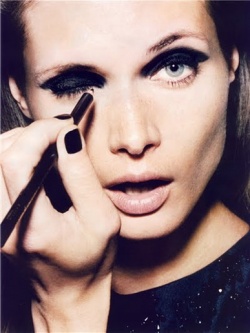Difference between revisions of "Makeup"
(Created page with "thumb|250px| Makeup (gandhavilepana) is cosmetic or perfumed substances put on the body for the purposes of beautification by masking blemishes and cov...") |
|||
| Line 1: | Line 1: | ||
[[File:Makeup.jpg|thumb|250px|]] | [[File:Makeup.jpg|thumb|250px|]] | ||
| − | |||
| − | One of the eight Precepts which committed Buddhists practise on half and full-moon days is not to use makeup or personal adornment (A.IV,250). Harmless in themselves, makeup and adornment represent the desire to make things appear different from what they actually are. At least twice a month serious lay Buddhists abstain from applying makeup and give themselves to recognizing, accepting and being content with the present reality. Monks and nuns are asked not to use ‘garlands, perfumes, cosmetics, ornaments and adornments’ for the reasons just stated and also because they require so much time and expense (D.I,5). See Complexion and Perfumes. | + | |
| + | [[Makeup]] ([[gandhavilepana]]) is cosmetic or perfumed {{Wiki|substances}} put on the [[body]] for the purposes of beautification by masking blemishes and covering odours. In [[India]] during the [[Buddha’s]] time, women and sometimes men too, put powder (kakku) and rouge ([[manosilā]]) on their faces, painted their lips, palms and finger tips with lac ([[lākhā]]), rubbed [[sandalwood]] powder or oil on their [[bodies]] ([[candana]]) and painted their [[eyes]] with {{Wiki|collyrium}} ([[añjana]], D.I,7; Ja.V,302; Thi.145; Vin.II,107). | ||
| + | |||
| + | The [[Buddha’s]] cousin [[Nanda]], used to paint his [[eyes]] with {{Wiki|collyrium}}, which in men was a sign of {{Wiki|sophistication}} rather than of effeminacy. [[Smart]] young men would sometimes match the {{Wiki|colour}} of their [[makeup]] to the {{Wiki|colour}} of their [[clothes]] (D.II,96). | ||
| + | |||
| + | One of the [[eight Precepts]] which committed [[Buddhists]] practise on half and [[full-moon]] days is not to use [[makeup]] or personal adornment (A.IV,250). Harmless in themselves, [[makeup]] and adornment represent the [[desire]] to make things appear different from what they actually are. | ||
| + | |||
| + | At least twice a month serious lay [[Buddhists]] abstain from applying [[makeup]] and give themselves to [[recognizing]], accepting and being content with the {{Wiki|present}} [[reality]]. [[Monks and nuns]] are asked not to use ‘garlands, [[perfumes]], [[cosmetics]], ornaments and adornments’ for the [[reasons]] just stated and also because they require so much time and expense (D.I,5). See Complexion and [[Perfumes]]. | ||
{{R}} | {{R}} | ||
[http://www.buddhisma2z.com/content.php?id=246 www.buddhisma2z.com] | [http://www.buddhisma2z.com/content.php?id=246 www.buddhisma2z.com] | ||
[[Category:Buddhist Terms]] | [[Category:Buddhist Terms]] | ||
Latest revision as of 04:37, 8 January 2016
Makeup (gandhavilepana) is cosmetic or perfumed substances put on the body for the purposes of beautification by masking blemishes and covering odours. In India during the Buddha’s time, women and sometimes men too, put powder (kakku) and rouge (manosilā) on their faces, painted their lips, palms and finger tips with lac (lākhā), rubbed sandalwood powder or oil on their bodies (candana) and painted their eyes with collyrium (añjana, D.I,7; Ja.V,302; Thi.145; Vin.II,107).
The Buddha’s cousin Nanda, used to paint his eyes with collyrium, which in men was a sign of sophistication rather than of effeminacy. Smart young men would sometimes match the colour of their makeup to the colour of their clothes (D.II,96).
One of the eight Precepts which committed Buddhists practise on half and full-moon days is not to use makeup or personal adornment (A.IV,250). Harmless in themselves, makeup and adornment represent the desire to make things appear different from what they actually are.
At least twice a month serious lay Buddhists abstain from applying makeup and give themselves to recognizing, accepting and being content with the present reality. Monks and nuns are asked not to use ‘garlands, perfumes, cosmetics, ornaments and adornments’ for the reasons just stated and also because they require so much time and expense (D.I,5). See Complexion and Perfumes.
